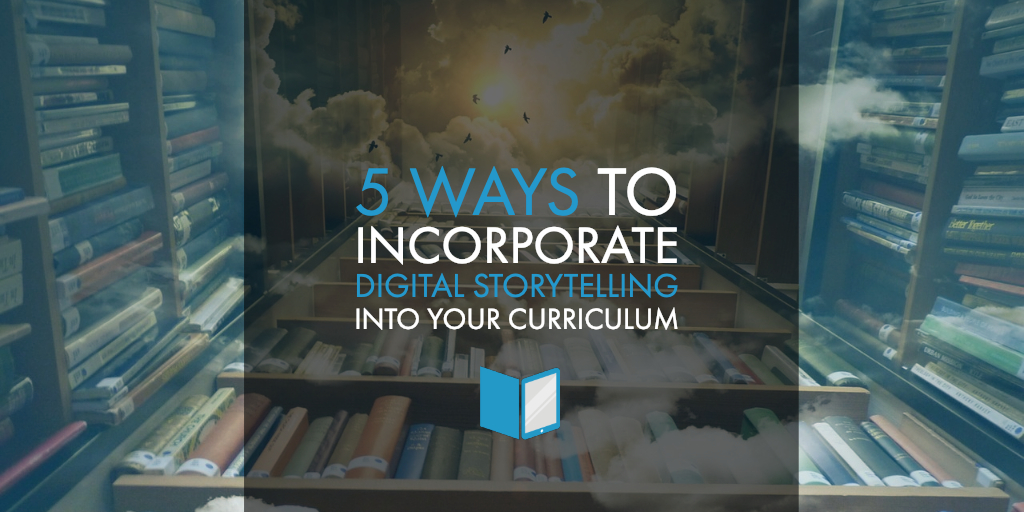In today’s era of tech-savvy students, traditional teaching methods are rapidly losing their attention. When juxtaposed with interactive digital assessments and demonstrations, old-fashioned study guides pale in comparison. Modern students demand modern learning solutions, and little by little educators and publishers have adapted their teaching methods to these learning styles. While online courses are likely the first solution that comes to mind, there are other ways to enrich digital learning to supplement classroom learning. Digital storytelling is one of these methods.
Storytelling is an art. It's often used throughout educational material to further reading comprehension, teach and demonstrate proper spelling and grammar and improve writing skills. Digital storytelling brings this common practice into the 21st century by adding videos, photos, music, graphics, and narration. It helps to spark student creativity.
The Center for Digital Storytelling (CDS) in Berkeley, California is well known for developing and driving the adoption of what they refer to as the 7 Elements of Digital Storytelling:
- Point of View; what is the main point of the story and what is the perspective of the author?
- A Dramatic Question; a key question that keeps the viewer's attention and will be answered by story's end.
- Emotional Content; serious issues that come alive in a personal and powerful way, connecting the audience to the story.
- The Gift of Your Voice; a way to personalize the story to help the audience understand the context.
- The Power of the Soundtrack; music or other sounds that support the story.
- Economy; using just enough content to tell the story without overloading the audience.
- Pacing; the rhythm of the story and how slowly or quickly it progresses.
In summary, these 7 elements provide a useful checklist for your students on how to best tell a story via a digital medium of any kind. For inspiration on how to apply these elements to specific academic scenarios, we've compiled 5 recommendations:
1. Trade Book Reports for Mini Movie Trailers
Students are often less than enthused when tasked with writing book reports, yet teachers have been assigning them for decades. With digital storytelling, summarizing and analyzing a book can become much more engaging. Rather than simply presenting a dull text-based retelling of the plot, students can create lively presentations that are more like trailers than summaries. Complete with music, narration, and even video, ye olde book report transforms into a lively interpretation of the story.
2. Bring Literature to Life with Illustrations
Poetry and required reading are not always as inspiring as intended. Students who struggle to decipher difficult prose often lose focus before they can appreciate the value of the material. In place of asking students to analyze a poem or novel, have them digitally illustrate it! By asking students to illustrate lines of a poem or their favorite excerpt from a story, they have a chance to bring their own perspective front and center. This exercise allows them to take a deeper look into the meaning behind the text while also expressing their own ideas in a creative and shareable way.
3. Current Events as News Reports
With many students getting the majority of their news from online sources, asking students to watch televised news and report on it may be a tall order. Instead, ask them to create a news report of their very own. Whether the report is on global warming or politics, recording themselves playing the part of a news anchor enables students to become active learners; rather than passively watching the news, they get to become passionate journalists themselves when presenting their report in class.
4. Turn History Lessons into Period Pieces
Learning history from a textbook is a dry and taxing pursuit for all but the biggest of history buffs. Within the recesses of those textbooks, however, are stories; stories about unique, fascinating, and exceptional events and individuals. With digital storytelling, learners can delve deeper into the lives of historical figures. In place of assigning traditional oral reports, students can create mini “period pieces.” To make the assignment more exciting, allow students to use any combination of digital media to create their presentation. Some students may opt to piece together humorous comics, while others may act out and record the events to create a short, live-action film.
5. Digital Personification of Any Topic
Asking questions is a powerful learning tool. The trick is knowing what questions to ask! Regardless of the topic, students can be asked to interview for subject matter to create lively, first-person presentations. For example, instead of passively telling the class about the function of a red blood cell a student can speak from the point of view of the cell itself. What does it do? How does it work? What are the cell’s likes and dislikes? Personifying can help the most tedious of topics become more relatable. These “characters” can become the stars of a digital presentation made up of photos or drawings. In this scenario, the “narration” must be in the first person, upping the fun factor by bringing voice acting to the table.
Why Digital Storytelling is a Valuable Learning Tool
Regardless of how educators implement digital storytelling in the classroom, it has tremendous appeal for today’s students. It allows a student to act as an expert on a topic while also practicing how to best leverage a variety of digital tools for learning and potentially for fun outside of the classroom. They can take an active, artistic, and exploratory role in their own education.
If you're looking for a tool that helps you organize and curate all of these teaching tactics in a way that helps you track student progress and performance, our Learning Management System and Assessment tools may be exactly what you need. We're happy to show you how:






Leave a comment